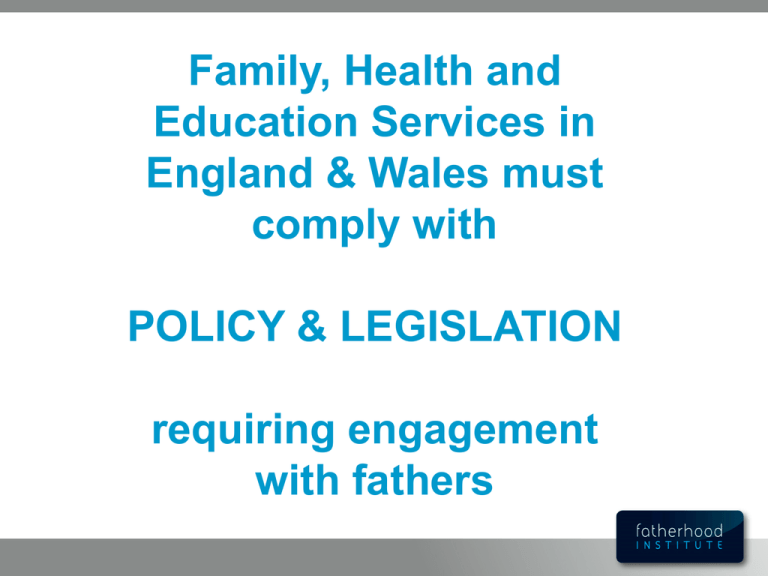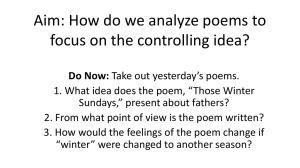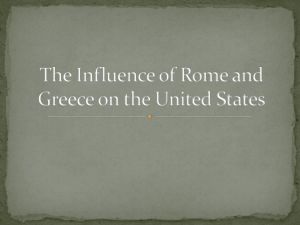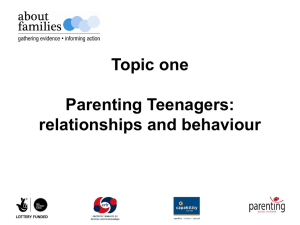and fathers - The Fatherhood Institute
advertisement

Family, Health and Education Services in England & Wales must comply with POLICY & LEGISLATION requiring engagement with fathers POLICY and LEGISLATION explicitly requiring engagement with fathers - e.g. 1. The Children Act (1989, 2004) 2. The Framework for the Assessment of Children in Need and their Families (DH, 2000) 3. The National Service Framework for Children, Young People & Maternity Services (DH/DfES, 2004) 4. Working Together to Safeguard Children (2006) 5. Routine postnatal care of women and their babies (NIHCE, 2006) 6. The Equality Act (2006) 7. Maternity Matters (DH, 2007) 8. The Children’s Centre Practice/Planning/Performance Management Guidance (DfES, 2006; 2007) 9 . Every Parent Matters (HM Treasury, 2007) 10 . Aiming High for Children (HM Treasury/DfES, 2007) GOVERNMENT POLICY and LEGISLATION explicitly requiring engagement with fathers (cont) 11. Teenage Parenting Strategy & Guidance (DCSF, 2007; 2008) + Teenage Pregnancy Independent Advisory Group Annual Report (2008) 12. The Children’s Plan (DCSF, 2007) 13. 2020 Children and Young People’s Workforce Strategy (DCSF 2008) 13. The Child Health Promotion Programme Update (DH, 2008) 14. SCIE guidelines for supporting parents (2008) 14. The Welfare Act (2009) 15. The Childcare Strategy (DWP, HM Treasury, DCSF, Cabinet Office, 2009) 16. Healthy lives, brighter futures: the strategy for children and young people’s health (DCSF, DH, 2009) 17. Getting Maternity Services Right for teenage mothers and young fathers (DH, DCSF, 2009) 18. Support for All (Green Paper on families) (DCSF, 2010) 19. Teenage Pregnancy Strategy: beyond 2010 (DCSF, DH, 2010) 20. Maternity and Early Years: making a good start to family life (DH, DCSF, 2010) 21. Parenting and Family Support: guidance for Local Authorities in England (DCSF, 2010) AND THE COALITION? So far, none of the previous guidance or legislation has been repealed. In addition, The Coalition has committed to: • encouraging shared parenting from the earliest stages of pregnancy • reducing gender inequalities at work • achieving a better gender balance in the early years workforce, • ensuring that both men and women use couple relationship support services (The Coalition - our Programme for Government: Freedom, Fairness, Responsibility - May, 2010) • reviewing the Family Justice System (June, 2010). The Children Act (1989) Fathers are parents under the Act irrespective of whether they have Parental Responsibility, so they should be involved in case conferences etc, where decisions are made The Framework for the Assessment of Children in Need and their Families (DH, 2000) Assessors must: ‘take all reasonable steps to gather information about, and from, all relevant family members, whether resident or not, and requires them to be clear about the roles played by fathers or father-figures.” The National Service Framework for Children, Young People & Maternity Services (DH, DfES 2004) requires Children’s Services to (i) engage systematically with fathers and mothers to improve children’s wellbeing; and (ii) consult with both parents over service design. National Institute for Health and Clinical Excellence (2006) Clinical Guideline: Routine postnatal care of women and their babies. “Postnatal care in the community should provide mothers and their partners or companions with information about how to nurture babies and what to expect at different ages, including growth and child development.” Maternity Matters (DH, 2007) High quality maternity care is not just about good professional care that ensures a healthy and safe pregnancy. It also involves access to a wide range of varied services that should work in partnership to help equip mothers and fathers with the skills they require to become confident and caring parents. The Childcare Act (2006) Requires local authorities to identify parents and prospective parents who are unlikely to use early childhood services e.g. fathers – who are specifically mentioned), and facilitate their access to those services. The Equality Act (2006) (i) Requires public bodies including health, education and those that commission children’s services to publish an action plan for promoting gender equality. (ii) At the point of commissioning, a gender impact assessment is required, assessing the differential impact of the service on women and men. (iii) Services must also gather information on how their services impact on men and women respectively, and consult with men and women who use them, in ways they find accessible. The Children’s Centre Practice Guidance and Planning and Performance Management Guidance (DfES, 2006) All Centres must: (i) have a strategy to publicise all their services to fathers specifically….and to communicate why their involvement will benefit their children and themselves” (ii) have effective systems to gather information about fathers in all the families with whom they are in contact (iii) routinely offer all fathers the support and opportunities they need to play their parental role effectively (iv) recruit and train all staff to be sensitive to the needs of fathers as well as mothers (v) consult with fathers and mothers before strategies are decided, and involve them in planning, delivery and governance of services (vi) engage particularly with groups of fathers who previously have been excluded from services and whose children are at risk of poor outcomes - including young fathers and black and minority ethnic fathers; (vii) monitor how far different groups of dads have accessed services, and what they thought of them. N.B. One of the Children’s Centres Performance Indicators requires Centres to assess how well they engage with fathers in the “most excluded groups”. Sure Start Children’s Centres: Phase 3 Planning & Delivery (DCSF, 2007) • ‘Working with Fathers’ is one of five priorities for all Centres • ‘Father-child relationships can have a profound and wideranging impact on the child that lasts a lifetime. Sure Start Children’s Centre services should be responsive to supporting fathers and father figures in their role as parent. A parent link or outreach worker with a specific remit to engage with fathers will be most effective. In smaller Phase 3 centres or clusters, a specialist fathers’ worker may need to be shared between centres. All other staff should also have the skills and confidence to engage with fathers, particularly on initial contact.’ Toolkit for Reaching Priority and Excluded Families (Together for Children, 2007) Contains a planning checklist on working with fathers which complements the Children’s Centres Practice Guidance Every Parent Matters (2007): “Irrespective of the degree of involvement they have in the care of their children, fathers should be offered routinely the support and opportunities they need to play their parental role effectively”. This requires systematic information gathering about – and engagement with – fathers in all children’s services: it is not enough just to offer “dads’ groups”. In general, these services must be available to fathers across all social groups - including disadvantaged dads, and those in groups which access services relatively rarely (e.g. young, BME, non-resident fathers). Aiming high for children: supporting families (HM Treasury/DfES 2007) • • • • • • New funding for work with fathers in Children’s Centres – e.g. outreach workers, parenting classes that work for fathers A focus on midwives and health visitors and their role in supporting both parents A Parents Charter that will define the responsibilities of services to mothers and fathers (explicitly) A specific critique of the word “parent” and how it excludes fathers. A new focus on the need to engage with separated fathers – with reference to caring and learning, rather than just financial support. A strong critique of how fathers are excluded from family services - and promotion of Fathers Direct’s Fatherhood Quality Mark as a solution. Teenage Parents Next Steps: Guidance for Local Authorities and Primary Care (2007, DH & DCFS) • Working with young fathers is to be a priority in teenage pregnancy; • Services are required to: “develop a culture in which the starting point is that young fathers’ involvement in the pregnancy and birth is beneficial for the mother and child and that services should be designed so that they are inclusive of young fathers, rather than one which starts with the presumption that the young father is a problem”. The Children’s Plan (2007) • Stresses the “need for public services to engage with both father and mother except where there is a clear risk to the child to do so” [CP Box 1.1]. • There is to be a new partnership between parents and schools “no matter what their personal circumstances – mothers, fathers, non-resident parents, lone parents and working parents” [CP 3.21]. • Health visiting services should deliver a “ . . . health promotion programme that is universal but tailored to the needs of children and families – both fathers and mothers” [CP Box 1.4]. Child Health Promotion Programme (Update, 2008) • “working routinely with both mothers and fathers (whether they are living together or not)”. [13] • “Fathers should be routinely invited to participate in child health reviews, and should have their needs assessed.” [9] • “Any system of early identification [of needs] has to be able to be acceptable to both parents.” [14] • Increased focus on pregnancy “and the need for mothers and fathers to be supported during this time”. [9, 13, 34] Child Health Promotion Programme (2008) • Increased focus on vulnerable children and families, including: Families with a young mother or father Families where the parents are not co-resident. [14-15] Useful predictors [of risk] during pregnancy include unstable relationships…obesity in parents….smoking by partners. [15-16] • Greater focus on parenting support, understanding parents’ priorities, goals and aspirations [13]: “Supporting mothers and fathers to provide sensitive and attuned parenting, in particular during the first months and years of life.” “Supporting strong couple relationships.” “Supporting the transition to parenthood, especially for first-time mother and fathers.” [8] “Ensuring that contact with the family routinely involves and supports fathers, including non-resident fathers.” Social Care Institute for Excellence Guidelines (2008) The role of parent can be challenging under any circumstances, especially where a child has behavioural difficulties or a parent is disabled or has other support needs . . . . . . Parents are fathers and mothers and this awareness of the role and inclusion of fathers is supported by policy and guidance. The Fatherhood Institute has summarised some of the key documents. The Childcare Strategy: Next Steps for Early Learning & Childcare (2009) “The role of a modern public service in early learning and childcare is . . . to empower mothers and fathers (1:10) “We will . . . involve and support fathers” (p.12) “It is important to engage with fathers as well as mothers in their parenting roles. Too often family services fail to recognise the role of fathers, to take on board their needs and actively engage with them as service users” (2:35). “The recently launched “Think Fathers” campaign is promoting the importance of all family services involving and supporting fathers” (2:35) “Fathers’ preferences also need to be remembered. As well as being beneficial for child outcomes, 87% of men think fathers should be very involved in looking after children” (8:44) The Child Health Strategy: Healthy lives, brighter futures: the strategy for children and young people’s health (DCSF, DH, 2009) • Review of how Healthy Child Programme is being implemented to include fathers [3.29] • Health visitor e-learning programme, including couple relationships [3.31] • Improvement of fathers' involvement in maternity services [3.32] • Ability for fathers to stay overnight now defined as best practice [3.34] • Review of antenatal education, with particular reference to fathers and excluded groups [3.36] • Healthy Child Programme pilot projects to test ways of reaching fathers • Fathers’ Early Years Life Check [3.39] Getting Maternity Services Right for Teenage Mothers and Young Fathers ( (DCSF, DH, 2009) The importance of young fathers: a young father’s behaviour and attitudes have a strong influence on the health of the young mother and the baby • The young father’s smoking/drinking/drug use is the greatest influence on the young mother’s smoking/drinking/drug use • The young father’s attitude to breastfeeding has a significant impact on the mother’s choice of how to feed her baby • A good relationship with the baby’s father and supportive behaviour by him is a protective factor for postnatal depression in the young mother; conversely, his negative behaviour is a risk factor for postnatal depression. • Relationship-stress between the couple is a significant causeof maternal stress – which can affect the unborn baby. . . The Welfare Reform Act (Nov, 2009) Legal change in England & Wales to require birth registration for unmarried fathers (as it is already for married fathers and all mothers), unless Registrar decides it is impossible, impracticable or unreasonable: • Gives mothers a new right to insist that unmarried fathers register on birth certificate • Gives unmarried fathers a new right to insist that they are registered • No compulsion on either parent to register but reasonable efforts are to be made to discover and register the father’s name The Welfare Reform Act (2009) (cont.) Non-legislative measures to promote and support joint birth registration – a duty on maternity staff and registrars to engage with both parents: • comprehensive new information about the changes tgiven to both parents • midwives encouraged to inform parents about registration - and the benefits of both parents’ signing • opportunity for fathers to register ante-natally in health service records • training for registrars • community outreach to reach fathers as well as mothers • ‘acknowledgement of paternity’ event at the birth N.B. This legislation is a development of the awarding, in December 2003, of automatic Parental Responsibility to all unmarried fathers registered on their babies’ birth certificates after that date. Currently, 93% of fathers registered at birth (45,000 children per year are registered with only one parent). Support for All: the government Green Paper on families and relationships (DCSF, 2010) A selection from the many references to fathers in this document: “An effective family policy must also be clear that parent means fathers as well as mothers… “Factors like smoking and maternal stress and mental health . . .are shaped by the relationships between mother and father . . . “A father’s involvement is important in contributing to attachment and child development. It is also good for mothers . . . “Research shows that when fathers are highly involved with their babies they are more likely to remain involved as their children grow up. This in turn has a significant benefit on children’s outcomes . . . “Services that have traditionally focused on child and maternal health and wellbeing . . . need to take steps to become more inclusive of fathers. . . . Support for All (cont.) A selection from the undertakings in respect of fathers in this document: • communicate …about new arrangements for Joint Birth Registration ... and bring the legal changes into effect from January 2011 • support plans by the Royal College of Midwives to produce guidance . . . on how best to engage fathers around the birth • ensure the free Bounty Packs given to women will also now include a guide specifically designed for fathers • review the notice period for the two week paternity leave period … examine the merits of introducing a paternity allowance. . . (enable) fathers . . . to take up to six months of additional paternity leave • (undertake a) communications and awareness campaign (about flexible working) aimed at supporting both fathers and mothers • And so on . . . Maternity and Early Years: making a good start to family life (DH, DCSF, 2010) ‘there will be new opportunities for fathers to get more involved - including an invitation for both parents to attend a Family Start meeting at their children’s centre and an opportunity to agree a Parents’ Plan together.’ * MEY: 4 (supported by a ‘starter kit’ for professionals encountering expectant and new mothers and fathers) ‘Fathers sometimes feel left out of a programme of health services that can be geared towards the mother and baby, making it harder for them to support the mother and baby themselves.’ MEY: 6 ‘We are pleased that the Royal College of Midwives and the Royal College of Obstetricians and Gynaecologists are working together to develop guidance for maternity staff to improve engagement with fathers.’ MEY: 27 ‘We will aim within the next 5 years that parents with babies in neonatal care can be confident a bed will be provided for them, so that both mothers and fathers can stay close to their baby.’ *Since this recommendation relies on Labour’s vision for Children’s Centres, it may not now come about Teenage Pregnancy Strategy: beyond 2010 (DCSF, DH, 2010) ‘Guidance issued to Local Authorities and Primary Care Trusts in 2007 set out what local areas should have in place to mitigate…risks [of poor child health; poor maternal well-being; poverty] , in particular to ensure: that maternity services are tailored to meet the needs of teenage mothers and young fathers’ TPS:10 ‘Referral pathways between maternity services and on-going support need to be clearly understood and watertight to prevent teenage mothers and young fathers slipping through the gaps between services and missing the support they need. And critically, all professionals and services need to be proactively welcoming to young parents to dispel the apprehensions which deters many of them from accessing the very services they need’. TPS: 34 ‘To further improve outcomes for teenage mothers and young fathers we will, through guidance to local areas, make clear the importance and cost benefits of including teenage parents in the needs assessment and commissioning of IYSS,TYS, early intervention and parenting strategies.’ TPS: 37 Also outlines support for teenage mothers and fathers through Care to Learn; Teenage Parents Supported Housing Pilot; FNP Parenting and Family Support: guidance for Local Authorities in England (DCSF, 2010) This non-statutory guidance brings together existing policy and guidance in the area of parent and family support. It updates 'Parenting Support' the previous guidance published in 2006, incorporating subsequent developments, including 'Think Family', and the families and relationships Green Paper 'Support for All'. It is a very father-friendly publication, referencing ‘Think Fathers’ and the ‘Dad Test’ and it encourages meeting fathers’ needs in all local public services. E.g.: ‘Local authorities are under a duty to provide mothers, fathers and other carers with accessible information about the services, support and advice available to help them support their children up to their 20th birthday. This is usually delivered through their Family Information Service, which should act as a central information point with links to local NHS provision, Sure Start Children’s Centres, Jobcentre Plus, schools, youth clubs, libraries etc.’ ‘Sure Start Children’s Centres Practice Guidance’ …stresses the importance of involving fathers, including young fathers, and non resident parents in their children’s care, learning and development, and includes advice on how to provide effective services for young fathers through children’s centres.’ • Think Fathers Guide - practical know how for services • Think Fathers Champions - services, commissioners, policymakers, employers etc who are committed to supporting father-child relationships. Register by emailing champions@fatherhoodinstitute.org • Dad Test - self assessment framework • Champions Plus subscription service, including detailed online Dad Test Logbook, support from Regional Development Officers, 10% discount on all products & services www.fatherhoodinstitute.org









